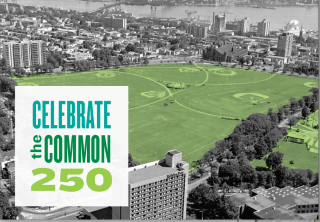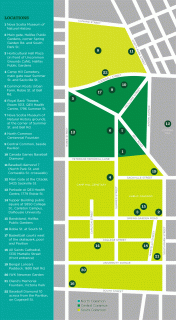On June 23, 1763, King George III granted the 235-acre Halifax Common “to and for the use of the inhabitants of the town of Halifax as common forever.” Today, exactly 258 years later, what we fondly call “the Commons” is a mere 20 per cent of that grant.

an 18th century song protesting the English enclosures stands proudly at St. Pat’s since 2019.
Some was used for public institutions. Some was sold to private developers for residential and commercial buildings. Another 20 per cent is for parking.
What happened here mirrors the loss of the commons in England.In 1773, just 10 years after our Halifax Common grant, the English Parliament passed the Enclosure Act allowing landlords to fence off and privatize common land and remove commoners’ access.
Such enclosures over time consumed a fifth of England’s total area. They marked the end of the feudal era and the beginning of commercial agriculture and the economic system we call capitalism.
The goose’s song That relentless enclosure of the Common and privatization of public land by so-called “public authorities” continues to this day.
For example, despite public consultations in 2015-16 strongly favouring community use of the public’s 3.3-acre St. Patrick’s High School site on Quinpool Road, Halifax regional council secretly sold the site last year for $37.6 million to developers.
Citizens wanted the space kept public — especially for the Common Roots Urban Farm. Now, 2019 zoning rules permit the developers to build up to 28 storeys there.
As a wonderfully pithy reminder of the rapacious hypocrisy of such state-aided privatizing of common space, an 18th century song protesting the English enclosures has stood proudly on that St. Patrick’s High site since 2019.
But the enclosure of the Common is not just a local story. And it’s not just ancient history. In fact, the theft of the Common is very literally the theft of our children’s inheritance. They will pay the bill for our present plunder.
Our global commons The commons, after all, are our air and our water, our soils and our forests — our beautiful planet Earth upon which we depend for our very survival, and which our predatory economic system is relentlessly looting and destroying.
But this economic system so cleverly covers its tracks and conceals its true costs.
The greedier we are, the more we shop and buy, the faster we cut down our forests, overfish, kill other species, heat the planet, and poison the earth, water and sky, the more the economy grows. We call that “progress” and “development” and a “healthy” economy.
To avoid counting the true costs of our economic activity, economists have invented a whole language to befuddle and confuse us. They only count what we produce, buy and sell — a counting system they blandly call Gross Domestic Product (GDP).
And any collateral damage, like pollution, climate change, stress, addiction, and growing inequality, they conveniently label “externalities,” meaning they don’t count those things. They make them invisible as they do everything for which no money is exchanged — like raising your child, like green spaces, like the generous volunteer work of those staffing our COVID-testing sites.
Starting in 1997, our Nova Scotia Genuine Progress Index measured what really counts. Sadly, though, governments still swallow the old economic myths hook, line and sinker.
And so it has been for 258 years as the Halifax Common and the Earth’s commons were carved up and enclosed to make way for capital and commerce. And so it is with the St. Pat’s lands today.
GDP won’t count the value of a community-run urban farm or the joy of a family playing on a green meadow. But it celebrates the $37.6-million sale of that meadow to a developer, and it can’t wait to count the concrete, steel, fossil fuels, rent income, and boutique sales in the tower that will rise there.
Taking it back So long as we refuse to value our commons, including this precious Earth, and turn a blind eye to its enclosure and privatization, we are wilfully complicit in its destruction and degradation.
And so, this 258th anniversary of the Halifax Common is bittersweet. We celebrate the precious green corner we have left, and can’t help but mourn the loss of what’s been stolen from the public domain and from our children.
Might we even use this moment of reflection to question our blind belief in this economic system whose harm now vastly exceeds its benefit?
Might we even dare to turn back the tide of expropriation? To honour the Indigenous view that “we belong to the land” instead of “the land belongs to us”? To reassert our common good? To take back our precious inheritance?
As that daring 18th century song on the St. Pat’s site proclaims: “Geese will still a common lack, Till they go and steal it back”! https://bit.ly/3qmtN7H
Guest Opinion: Ronald Colman of Halifax is founder of Genuine Progress Index Atlantic and author of What Really Counts: The Case for a Sustainable and Equitable Economy (Columbia University Press. 2021) Continue reading



